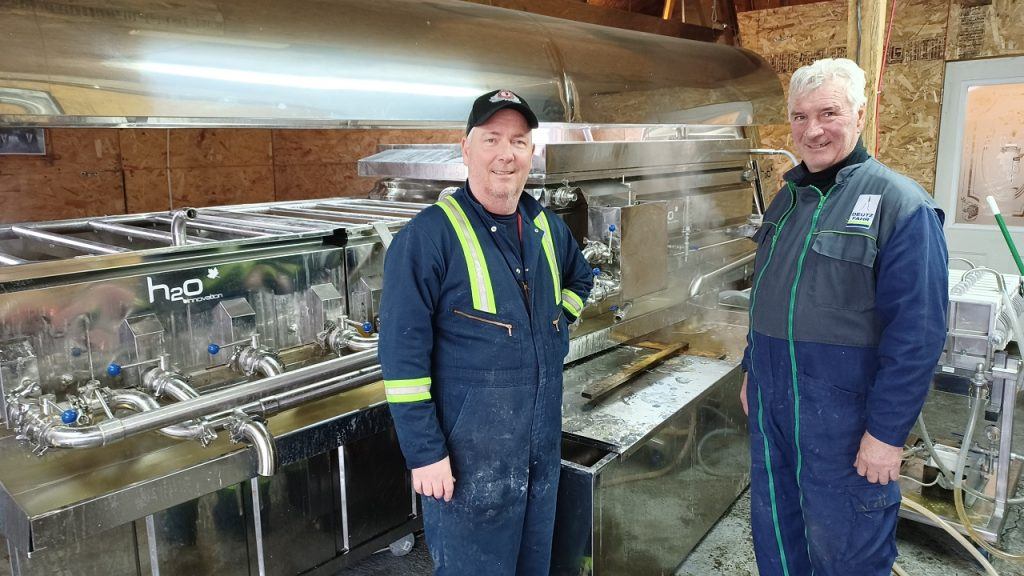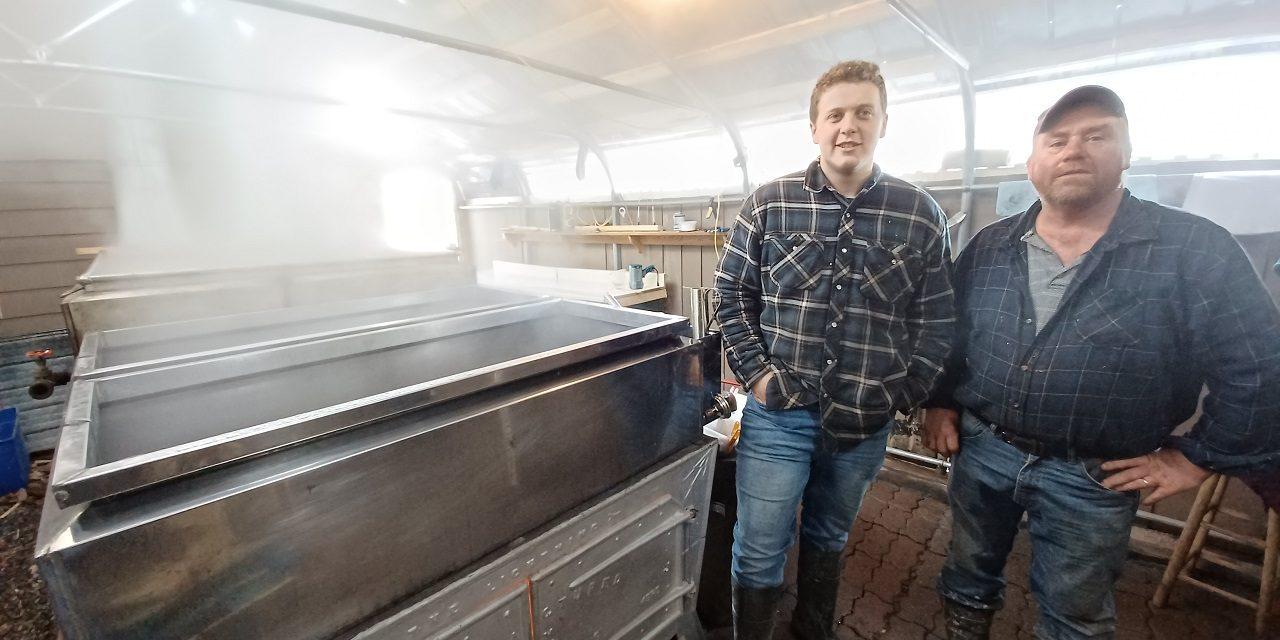Maple syrup season is more than old time images of buckets on trees and quaint little sugar shacks. In Argenteuil, and across Québec, maple syrup is business, technology, and education.
Harrison Neil just doesn’t make maple syrup, he studies it. He is presently completing the practical part of his course in maple syrup production at the Centre de formation agricole Saint-Anselme, an agricultural college in the Beauce region. Neil is doing his practical work at MND Maple Products in Grenville-sur-la-Rouge, but he has set up his own small sugar bush for practice, and to provide some syrup in cans for family and friends at his family’s home on Route 148 between Grenville and Calumet.
“It’s experience,” Harrison explains.
The course in Sainte-Anselme is seven months long. Four months are spent at the campus and the final three months are practical work. Harrison was working in excavation after he finished secondary school and then worked one season at MND, and that experience made him decide to take the course.
“I enjoyed doing it during the winter, so I tried the course out,” he says.
Harrison has tapped 400 trees on his family’s 40-acre property the old-fashioned way – with pails and a short length of pipeline to collect the sap. The sap is boiled using a wood-fired Lightning brand evaporator that is more than 50 years old and previously belonged to retired maple syrup maker Winston Hodge, of St-André-d’Argenteuil.
“Harrison and I approached him to buy it,” says Glenn Neil, Harrison’s father.
The old Lightning evaporator has a brick-lined firebox and can boil 120 gallons of sap per hour, which results in just three gallons of maple syrup. Moving the heavy unit into place required some hard labour.
“It took eight people and strong arms,” Harrison says.
With maple syrup such a big business and part of Québec society, it is no surprise there are college course on how to become an expert at producing it. However, demand for syrup school is greater than the number of people to teach it.
“There’s a lot of people wanting to get in the course but there aren’t enough teachers,” Harrison says.
Technology and supply management
At Les Sucreries Lachute, Denis Lalande has been producing maple syrup for 23 years on the historic, 304-acre farm, located just west of Lachute on Route 158. The farm previously belonged to the Jackson and Hanly families. Lalande has tapped 10,200 sugar maple trees on his property which feed into lines leading to a collection tank.
Denis’ son Hugo and 18-year-old grandson Ulysse help with maple syrup production. The Lalande’s have invested in a large new H20 brand evaporator and reverse osmosis system for syrup production this year. Reverse osmosis systems remove more water from the sap and reduce the amount of time required to boil the sap until it becomes syrup.
Previously, Hugo tended to the lines and sap collection in the woods, and this is his first season at the controls of the new high-tech system in the sugar shack near the barn.
“It’s like a brand-new Corvette,” Hugo says.
When maple syrup season ends, Hugo will begin a new season in his regular job as a captain aboard cargo ships on the St. Lawrence River and Great Lakes.
As of Thursday, March 24, the Lalande’s had produced approximately 25 barrels of maple syrup. Each stainless-steel barrel holds 30 to 34 gallons. In Québec, most maple syrup production is supply managed, just like milk production across Canada. The Lalonde’s are members of the supply management federation, the Producteurs et productrices acéricoles du Québec (PPAQ). The Lalande’s have 10,000 pounds worth of quota in the system, which is approximately 57 barrels. The barrels are transported to PPAQ’s secure facility where a vast reserve of maple syrup is stored and marketed as required. If a producer ships more than their quota to PPAQ, they are not paid for it. However, the excess amount may be banked for another year if they ship fewer barrels than usual.
“It stabilizes my income. I’m sure of having the same income all the time,” Denis says.
PPAQ producers are also permitted to sell small quantities to local customers in smaller containers.
Temperatures did not go below freezing for a few nights last week, which meant the sap kept running, and the Lalande’s had to keep collecting and boiling, which resulted in very little sleep. They were looking forward to a break with colder temperatures early this week in anticipation of a second part to the season extending into early April.

Hugo Lalande, left, and his father Denis Lalande, right, beside their new evaporator at Les Sucreries Lachute. Photo: James Morgan
Producer in two provinces
At MND Maple Products in Grenville-sur-la-Rouge, the season has been off to a good start, according to owner Dale Cruise. MND also has a large, modern evaporator and reverse osmosis system. They boiled sap for the first time on March 12. Cruise said that has only happened four times in the 22 years he has been producing maple syrup and it has been a good season so far with the right temperatures and minimal sunshine to keep the lines cool.
MND has tapped 25,000 trees using an elaborate network of lines. MND is not part of the PPAQ, so its products are only sold in small containers at its Scotch Road shop, and at other local retailers. MND also has an Ontario division called Fine and Dandy near Vankleek Hill which uses sap from Ontario trees for the Ontario market.
At its shop on Scotch Road near Autoroute 50, MND also sells maple butter, maple sugar candy, and a variety of maple baked goods, all produced on location. Cruise is optimistic the second half of this year’s maple season will be as good as the first.
“I’m sure we’re going to have two more weeks,” he said.

MND Maple Products owner Dale Cruise filling a container with fresh maple butter while Brian Stevenson feeds maple syrup into the machine. Photo: James Morgan


